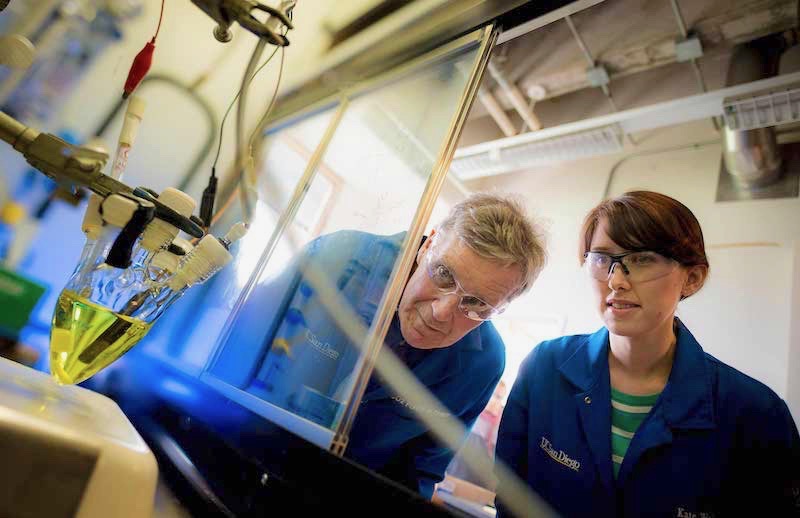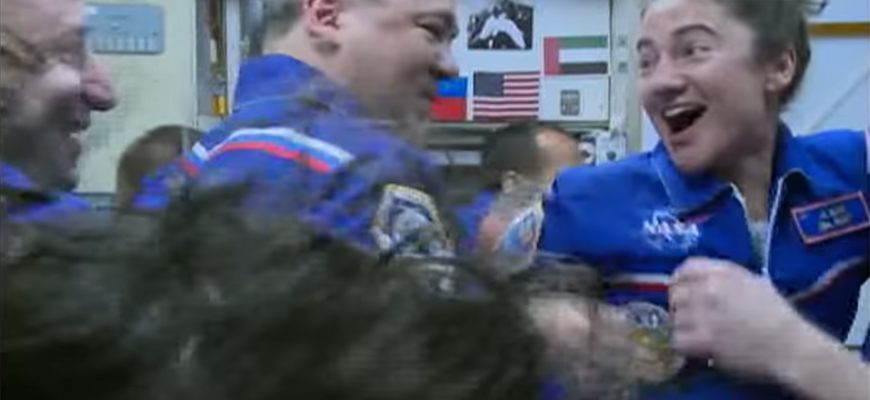Daily Business Report-June 16, 2017
Chemists Clifford Kubiak and Kate Waldie, at right, are working on a device that chemically splits carbon dioxide into oxygen and carbon monoxide. Kubiak is a professor of chemistry and biochemistry and Waldie is a postdoctoral fellow working in his laboratory. (Photo by Erik Jepsen/UC San Diego Publications)
International Solar Fuels Conference Lands
in U.S. for the First Time — at UC San Diego
By Kim McDonald | UC San Diego News Center
More than 300 researchers from around the world will travel to UC San Diego July 6-10 for an international meeting designed to showcase new biological and chemical approaches to utilizing solar energy for direct fuel production.
Officially billed as the second biannual International Solar Fuels conference, the scientific meeting is being held on U.S. soil for the first time.
Organizers of the first conference, held two years ago in Uppsala, Sweden, chose UC San Diego as the venue for the second solar fuels conference because of its leadership in algae biofuels and artificial photosynthesis research—specifically the work of Stephen Mayfield, a professor of biology, and Clifford Kubiak, a professor of chemistry and biochemistry.
“This meeting is about jobs, the thousands of jobs that will come from the technologies that will be described in this meeting,” said Mayfield. “This meeting is about the development of technologies that will turn sunlight and CO2 into valuable products—products like fuels, feeds and even food. Products like renewable plastics, medicines and even clean water.”
While progress in this area of research is moving ahead at a rapid pace toward commercialization, organizers of this year’s conference, co-sponsored by the U.S. Department of Energy’s Office of Energy Efficiency and Renewable Energy, concede the meeting comes at particularly challenging time for U.S. researchers in the field.
That’s because the Trump administration last month demanded that Congress slash DOE’s energy efficiency and renewable energy programs by a massive 70 percent in the fiscal year beginning in October—a blow that, if enacted, will put the United States at a severe disadvantage in developing new clean and renewable energy technologies such as solar fuels.
“The Administration’s budget proposal would put us behind China and Europe, blunting our competitive edge in a multi-trillion dollar developing clean energy global market,” said former U.S. Secretary of Energy Ernest Moniz, now a professor of physics and engineering at MIT.
Among the topics discussed at the upcoming meeting will be ways of chemically producing energy through artificial photosynthesis, catalysis and electrochemistry, as well as biological approaches of producing clean energy, such as genetic engineering pond scum to produce high quality algae biofuels.
Mayfield and two professors in UC San Diego’s Department of Chemistry and Biochemistry, Michael Burkart and Skip Pomeroy, are working on a variety of research projects designed to make the production of transportation fuels, as well as other petroleum-based products, from algae commercially viable.
Kubiak, meanwhile, has been working in his Pacific Hall laboratory on several ways of chemically mimicking the process of photosynthesis and using sunlight with a semiconductor and two thin layers of catalysts to “split” carbon dioxide into oxygen and carbon monoxide.
“Carbon monoxide, or CO, is an important industrial chemical, which is normally produced from natural gas,” said Kubiak. “So with CO2 splitting you can save fuel, produce a useful chemical and reduce a greenhouse gas.”
Millions of pounds of carbon monoxide are used each year to manufacture chemicals, including detergents and plastics. The molecule can also be converted into a liquid fuel.
The device developed in Kubiak’s laboratory splits carbon dioxide to generate carbon monoxide and oxygen in a three-step process. The first step is the capture of solar energy photons by the semiconductor. The second step is the conversion of optical energy into electrical energy by the semiconductor. The third step is the deployment of electrical energy to the catalysts. The catalysts convert carbon dioxide to carbon monoxide on one side of the device and to oxygen on the other side.
Kubiak said that researchers in the nascent discipline of solar fuels are beginning to form small businesses from their laboratory discoveries.
“But the field is not mature yet to create big business,” he added. “Many decisions still need to be made at the technical level, like: If you use solar energy to make something of value from CO2 what should you make? Gasoline in one step? Not likely. Methanol, then gasoline from that? Possibly. Do you use membranes to concentrate CO2 or use microbes? What are the opportunities between say synthetic biology and molecular catalysis? This meeting will be important because many of the best people in the world will be here to present and discuss results that will move this field forward.”
It’s also why maintaining the federal investment in solar fuels and other renewable energy research is so critically important now for U.S. industry.
“The nation that is able to take the ideas discussed at this meeting and turn them into products will be in a great position to create the jobs of the future,” said Mayfield. “Those countries that invest in the research are going to be the countries that get those jobs. I hope that will be the United States. California is a leader in this area of research today, but it may well be that our government will stop our investment in this area of research. Then those jobs will go to China, Europe, or countries smart enough to make that investment.”
More information about the conference, which will run from July 6 to 10, as well as a July 9 public lecture on “Creating CO2-based Products,” can be obtained at http://isf2.ucsd.edu/
Click here for the UC San Diego News Center article
______________________

San Diego Companies Highlight Innovation
Zone During BIO International Convention
The 2017 BIO International Convention — in partnership with the National Institutes of Health and the National Science Foundation — will showcase 80 early-stage biomedical companies that have received Small Business Innovation Research grants. The program gives small entrepreneurial startups the opportunity to show off their technologies and gain access to business expertise.
The 2017 BIO convention runs Monday through Thursday next week and is expected to draw more than 16,000 attendees from 70 nations, and more than 1,800 exhibitors to the San Diego Convention Center. In addition, BIO 2017 will feature thematic exhibits and presentations, such as the Digital Health Zone, Start-Up Stadium and BIO Talent Connect.
Companies in the BIO Innovation Zone will receive branded exhibit space on the convention floor and access to BIO’s One-On-One Partnering, helping them connect with thousands of potential business partners.
San Diego-based firms will be well-represented at the Innovation Zone, with eight companies that are pushing the boundaries of biomedical science exhibiting.
- Amprionmakes high-throughput systems to detect the misfolded proteins associated with neurodegenerative diseases,
- DNAtrixdevelops virus-based therapies to treat deadly brain tumors
Histogen is creating cell-based therapies for orthopedics, wound healing and hair loss.
- Novoron Biosciencesis finding new ways to treat central nervous system disorders.
- Quoolabsengineers antibodies for therapeutic and other uses.
- Seacoast Sciencemakes tiny chemical sensors
TEGA Therapeutics uses glycans (sugars) to enhance enzyme replacement therapies.
- Vala Sciencescreates novel cell analysis tools
“Early stage R&D has proven to be the driving force in many breakthrough technologies under development today. Any one or more of the companies represented in our Innovation Zone could produce the next breakthrough that could change the lives of people desperate for a cure or treatment,” said BIO’s president and CEO, Jim Greenwood. “As SBIR recipients, the Innovation Zone’s companies have demonstrated strong potential for commercializing innovative and transformational technology that could change the medical health landscape.”
Innovation Zone companies receive a custom kiosk, exhibitor access, partnering support and other benefits. In addition, select companies will have the opportunity to pitch their company to a large audience.
______________________

Bankers Hill Apartments Sold for $2.4 Million
A five-unit apartment building at 151 W. Kalmia St. in Bankers Hill has been sold for $2.4 million to the Robert Miles Living Trust. Puji Development LLC was the seller.
The two-story property, which features a mix of high-end one-bedroom and two bedroom units, recently underwent extensive interior and exterior renovations. The property was fully occupied at the time of sale.
Colliers International represented the seller in the transaction.
______________________

San Diego-Based Uqora Wins Pitch Contest
and Chance to Compete in SBA Finals
Jenna Ryan, founder of Uqora, was the overall winner of a pitch contest hosted by business accelerators Hera Labs and UC San Diego’s mystartupXX. Ryan demonstrated that her women’s health company and its drink mix that provides defense against urinary-tract infections (UTIs) has the potential to make a measurable impact on the lives of women.
As the winner, Ryan will advance to be considered for the U.S. Small Business Administration’s InnovateHER Finals, which take place in September. Top prizes total $70,000.
As winner of the regional InnovateHER competition, Ryan was awarded an in-kind donation of mentoring by Seed San Diego, valued at $1,000. Uqora’s health supplement was inspired by the numerous women who suffer from repeated UTIs. According to University of Maryland Medical Center, more than 50 percent of women will get a UTI in their lifetime, and many suffer from repeat infections.
“Uqora is a game changer — it could be the next Airborne for women,” said Dr. Silvia Mah, Hera Labs’ executive director. “We were particularly impressed with her presentation and the fact that her product was clearly female-focused.”




